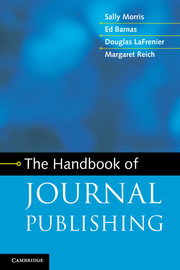Book contents
- Frontmatter
- Contents
- Preface and acknowledgments
- 1 Introduction to journals
- 2 Managing journals
- 3 Editing
- 4 The production process
- 5 Journal metrics
- 6 Marketing and sales
- 7 Fulfillment
- 8 Journal finances
- 9 Subsidiary income
- 10 Contract publishing
- 11 Copyright and other legal aspects
- 12 Ethical issues
- 13 The future of scholarly communication
- Appendix 1 Glossary
- Appendix 2 Resources
- Appendix 3 Vendors
- Index
- References
13 - The future of scholarly communication
Published online by Cambridge University Press: 05 March 2013
- Frontmatter
- Contents
- Preface and acknowledgments
- 1 Introduction to journals
- 2 Managing journals
- 3 Editing
- 4 The production process
- 5 Journal metrics
- 6 Marketing and sales
- 7 Fulfillment
- 8 Journal finances
- 9 Subsidiary income
- 10 Contract publishing
- 11 Copyright and other legal aspects
- 12 Ethical issues
- 13 The future of scholarly communication
- Appendix 1 Glossary
- Appendix 2 Resources
- Appendix 3 Vendors
- Index
- References
Summary
Scholarly communication
The primary objective of a scholar’s work is to answer questions or solve problems. The nature of the questions or problems may be very different in the sciences and the humanities, but the underlying objective is the same.
This work, however, achieves nothing unless it is communicated. Scholars communicate with each other in order to test and develop their ideas, as well as to set down a personal marker for their discoveries and insights. They do this in a whole spectrum of different ways, ranging from the completely informal (e.g., face-to-face, telephone, or email “conversation”) to the completely formal (e.g., publication in a journal article or book). And formal publication is itself only a means to an end – that of getting the author’s work accepted by others, and eventually integrated into the body of the world’s knowledge.
More than a decade ago, publisher Arthur Smith (Smith, 2000) nicely described the range of ways in which scholars communicated in the past, and might do in the future – see Figures 13.1 and 13.2. He illustrated how publication in a journal is just one stage in a sequence which moves from the author’s first, preliminary private communications to the eventual adoption of his or her findings by the wider world.
Smith’s view of the potential impact of electronic media (shown in Figure 13.2) was remarkably prescient. While the stages of communication, and the degrees of completeness/formality, have remained the same, the advent of online means of achieving these ends has placed increasing control in the hands of authors and their institutions, particularly at the stage of “communication.”
- Type
- Chapter
- Information
- The Handbook of Journal Publishing , pp. 380 - 402Publisher: Cambridge University PressPrint publication year: 2013

